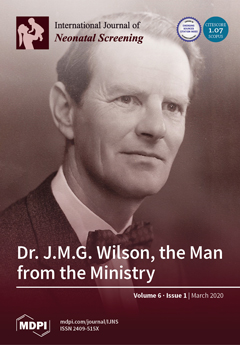Open AccessArticle
Incorporation of Second-Tier Biomarker Testing Improves the Specificity of Newborn Screening for Mucopolysaccharidosis Type I
by
Dawn S. Peck, Jean M. Lacey, Amy L. White, Gisele Pino, April L. Studinski, Rachel Fisher, Ayesha Ahmad, Linda Spencer, Sarah Viall, Natalie Shallow, Amy Siemon, J. Austin Hamm, Brianna K. Murray, Kelly L. Jones, Dimitar Gavrilov, Devin Oglesbee, Kimiyo Raymond, Dietrich Matern, Piero Rinaldo and Silvia Tortorelli
Cited by 27 | Viewed by 5646
Abstract
Enzyme-based newborn screening for Mucopolysaccharidosis type I (MPS I) has a high false-positive rate due to the prevalence of pseudodeficiency alleles, often resulting in unnecessary and costly follow up. The glycosaminoglycans (GAGs), dermatan sulfate (DS) and heparan sulfate (HS) are both substrates for
[...] Read more.
Enzyme-based newborn screening for Mucopolysaccharidosis type I (MPS I) has a high false-positive rate due to the prevalence of pseudodeficiency alleles, often resulting in unnecessary and costly follow up. The glycosaminoglycans (GAGs), dermatan sulfate (DS) and heparan sulfate (HS) are both substrates for α-
l-iduronidase (IDUA). These GAGs are elevated in patients with MPS I and have been shown to be promising biomarkers for both primary and second-tier testing. Since February 2016, we have measured DS and HS in 1213 specimens submitted on infants at risk for MPS I based on newborn screening. Molecular correlation was available for 157 of the tested cases. Samples from infants with MPS I confirmed by
IDUA molecular analysis all had significantly elevated levels of DS and HS compared to those with confirmed pseudodeficiency and/or heterozygosity. Analysis of our testing population and correlation with molecular results identified few discrepant outcomes and uncovered no evidence of false-negative cases. We have demonstrated that blood spot GAGs analysis accurately discriminates between patients with confirmed MPS I and false-positive cases due to pseudodeficiency or heterozygosity and increases the specificity of newborn screening for MPS I.
Full article
►▼
Show Figures






